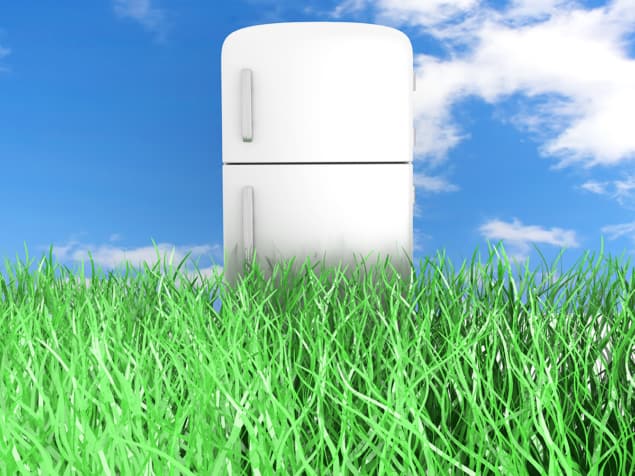
A new type of refrigerant that makes use of “colossal barocaloric effects” has been developed independently by two teams in China and Europe. The solid material undergoes changes in temperature as it is compressed and expanded. The research could lead to the development of cooling systems that do not rely on hydrofluorocarbons, which are not environmentally friendly.
As some hot regions of the world become wealthier – and as global warming continues — the demand for cooling technologies such as refrigeration and air conditioning will grow. Even when run on renewable energy, conventional refrigerators and air conditioners present a significant environmental hazard if not properly maintained and disposed of. This is because they use volatile hydrofluorocarbon fluids, which are extremely powerful greenhouse gases. Indeed, one kilogram of a typical hydrofluorocarbon has an equivalent global warming potential to two tons of carbon dioxide.
In a conventional refrigerator or air conditioner, a refrigerant is pumped around a closed system and undergoes changes from liquid to gas and then back to liquid. The expansion to a gas requires energy, which is acquired by cooling the surroundings on the cold side of the system. This heat is released on the hot side of the system when the fluid is condensed back to a liquid.
Squeezed states
This cycle can be achieved using any substance that undergoes a phase transition that involves the absorption and emission of heat. This includes electrocaloric and magnetocaloric materials, which switch between two solid phases in response to applied electric or magnetic fields. Unfortunately, heat capacities of most electrocaloric and magnetocaloric refrigerants are modest, producing cooling cycles that are too inefficient for widespread use. Another option is the barocaloric effect, which occurs when a solid material is compressed and expanded. For most materials, however, the effect is very small at ambient temperatures and pressures.
In the new research, two groups – one in China and one in Europe – have independently shown that colossal barocaloric effects can be achieved in plastic crystals at relatively modest pressures near room temperature. These plastic crystals comprise a lattice of organic molecules. At low pressures, the molecules are far enough apart that their relative orientations are effectively random, giving the system high entropy. This phase plays the role of the gas in a conventional cooling system. When the pressure is raised, however, the molecules are pushed closer together until they can no longer move independently and become a low-entropy ordered crystal. This large decrease in entropy releases a huge amount of heat. Whereas typical caloric materials show entropy changes of tens of joules per kilogram per Kelvin, some plastic crystals have entropy changes of over 600 J kg-1 K-1.
A step in the right direction for improving green cooling technologies
Daniel Errandonea, University of Valencia
Both teams used plastics based on neopentyl glycol (NPG) as their refrigerant. The entropy change associated with the phase transition (as measured by the Chinese researchers) was 389 J kg−1 K−1. Crucially, “the phase transition temperature of NPG is just around room temperature, which is most important for refrigeration applications,” explains Bing Li of the Chinese Academy of Sciences, who led the Chinese research.
Volume change
The European researchers – led by Josep-Lluís Tamarit of the Polytechnic University of Catalonia in Barcelona and Xavier Moya of the University of Cambridge – considered the entropy change not just from the phase transition itself but also from the associated volume change. They therefore measured a higher figure of 510 J kg-1 K-1 , which is on par with commercial hydrofluorocarbon refrigerants. This did, however, require higher pressures than used by the Chinese researchers.

Keeping buildings cool by sending heat into outer space
The next step is to put the technology into practice: “The efficiency has to be directly evaluated in a real refrigeration machine, which involves many factors aside from the entropy changes we reported here,” explains Li. “We are working on designing a prototype refrigerator based on the barocaloric effect.”
“I think what the researchers are proposing is a very nice idea, and this colossal barocaloric effect is probably an order of magnitude larger than caloric effects in other materials,” says Daniel Errandonea of the University of Valencia in Spain, who not involved in the research. He does have some concern about “ how long these materials – which are organic compounds – will last if you cycle them constantly in everyday applications”. He adds that the research is “a step in the right direction for improving green cooling technologies…if the science can be transferred to other materials which are more durable it will be perfect.”
Li and colleagues describe their work in Nature and Taramrit and Moya’s team describe their work in a preprint on arXiv.



